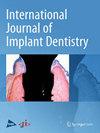对影响种植牙口内扫描准确性的因素进行系统回顾,重点关注扫描体
IF 3.1
3区 医学
Q1 DENTISTRY, ORAL SURGERY & MEDICINE
引用次数: 0
摘要
本系统性综述旨在探索和确定影响种植牙口内扫描准确性的因素,尤其关注扫描体 (ISB)。本研究遵循 PRISMA 2020 指南,对 MedLine、PubMed 和 Scopus 进行了全面的电子检索,以确定相关研究。根据标题、摘要和全文对文章进行了相关性筛选。罗宾斯 I 工具评估了各类研究的偏倚风险。根据研究标本和评估结果的预定参数进行数据提取。有 16 项研究符合规定的标准,因此被纳入系统综述。由于所选研究的变量和方法各不相同,因此无法对结果进行统计比较。因此,考虑到综述文献中存在大量异质性,我们选择了描述性综述方法。虚拟扫描结果的精确性取决于 ISB 和种植体的不同特征。这些因素包括它们在牙弓中的位置、结构设计、形状、材料成分、颜色和制造系统,所有这些都会影响扫描精度。此外,口内扫描仪(IOS)的类型、扫描技术、扫描辅助工具的使用、种植体之间的距离、扫描跨度和种植体的数量等因素也值得评估。在捕捉种植体位置方面,使用 ISB 的口内扫描显示出与传统印模方法相当的准确性,尤其是在单颗种植体和短跨度的情况下。但是,现有数据缺乏足够的活体应用信息来制定临床建议。本文章由计算机程序翻译,如有差异,请以英文原文为准。
A systematic review of factors impacting intraoral scanning accuracy in implant dentistry with emphasis on scan bodies
The purpose of this systematic review was to explore and identify the factors that influence the accuracy of intraoral scanning in implant dentistry, with a specific focus on scan bodies (ISBs). Following the PRISMA 2020 guidelines, this study conducted a thorough electronic search across MedLine, PubMed, and Scopus to identify relevant studies. Articles were screened based on titles, abstracts, and full texts for relevance. The Robins I tool assessed the risk of bias in various study types. Data extraction occurred based on predetermined parameters for studying specimens and assessing outcomes. 16 studies met the specified criteria and were consequently included in the systematic review. Due to variations in variables and methods across the selected studies, statistical comparison of results was not feasible. Therefore, a descriptive review approach was chosen, acknowledging the substantial heterogeneity in the reviewed literature. The precision of virtual scan results is contingent upon diverse characteristics of ISBs and implants. These factors encompass their placement within the dental arch, structural design, shape, material composition, color, and the manufacturing system, all of which contribute to scan accuracy. Additionally, considerations such as the intraoral scanner (IOS) type, scanning technique, use of scan aids, inter-implant distance, scan span, and the number of implants warrant evaluation. In the context of capturing implant positions, intraoral scanning with ISBs demonstrates comparable accuracy to traditional impression methods, particularly in single and short-span scenarios. However, the existing data lacks sufficient information on in vivo applications to formulate clinical recommendations.
求助全文
通过发布文献求助,成功后即可免费获取论文全文。
去求助
来源期刊

International Journal of Implant Dentistry
DENTISTRY, ORAL SURGERY & MEDICINE-
CiteScore
1.70
自引率
7.40%
发文量
53
审稿时长
13 weeks
期刊介绍:
The International Journal of Implant Dentistry is a peer-reviewed open access journal published under the SpringerOpen brand. The journal is dedicated to promoting the exchange and discussion of all research areas relevant to implant dentistry in the form of systematic literature or invited reviews, prospective and retrospective clinical studies, clinical case reports, basic laboratory and animal research, and articles on material research and engineering.
 求助内容:
求助内容: 应助结果提醒方式:
应助结果提醒方式:


